Collecting
and Phonographia
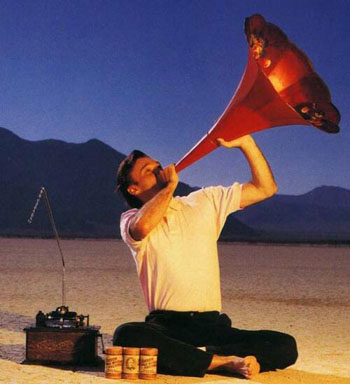
One
Collector's Perspective
By
Doug Boilesen 2018
My
phonographia
collection began when I purchased a Victrola at age twelve with
money from my paper route. Auctions and antique stores were early
sources for adding to the collection but I didn't pursue many
machines and certainly not rare ones.
Through
the years my collecting interests took some turns but collecting
always revolved around phonographs and its related ephemera.
Why
this fascination with talking machines, recorded sound and phonograph
ephemera?
Here
are three possibilities.
First,
the phonograph is based on a very simple technology yet what it
did was revolutionary and almost magical. It was revolutionary
because it changed human's perception of sound. It was a wonder
and magical because it was initially an early example of Arthur
C. Clark's adage known as his Third Law, i.e., "Any
sufficiently advanced technology is indistinguishable from magic."
As the phonograph moved into the home, however, it became part
of everyday life and lost its magic.
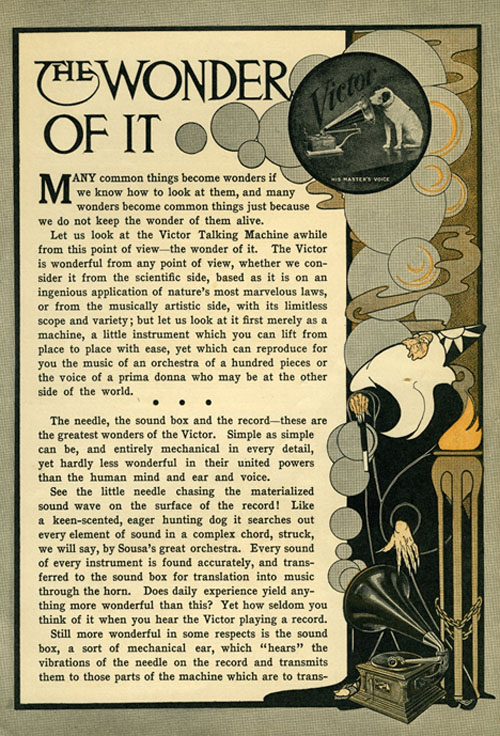
Victor Advertising
Brochure 1906 - "Does daily experience yield anything
more wonderful than this?"
Second,
the phonograph is an interesting example of how one invention
can produce so many popular culture ripples and connections --
and not just for one generation. In fact, the phonograph has played
in every decade since its invention and still plays music from
its grooves today by the vinyl enthusiasts of the 21st century.
The phonograph's advertising themes likewise have been repeated
each decade up to the present. Descendent home entertainment devices
continued the phonograph's advertised promise of offering personal
entertainment to anyone, anytime and as often as you wanted.
And
third, early phonographs such as morning-glory horn machines and
stately Victrolas are icons of recorded sound and home entertainment
with its story told by museums, social and cultural historians,
and collectors. (5A)
As
part of consumerism promoting the home is your castle the
phonograph uniquely offered everyone in the family the "best
seat in the house." That theme has been in home entertainment
ads since the mid-1890's and has never stopped.
Every
new home entertainment device using recorded sound has promoted
that "best seat" message: the phonograph with its multiple
record speeds and hundreds of millions of records; the radio;
the television; the tape recorder; VCRs, CDs, Laserdiscs and CED
Video Discs, DVDs, audio books, music streaming services, etc.
-- each of these sound and entertainment providers continued
the phonograph's revolutionary promise that your home could be
your own "Stage of the World" -- entertainment experiences
of the world were available to you as if you were a king, or a
millionaire or the possessor of Aladdin's Lamp.
"Seventh
row, center. Forever."
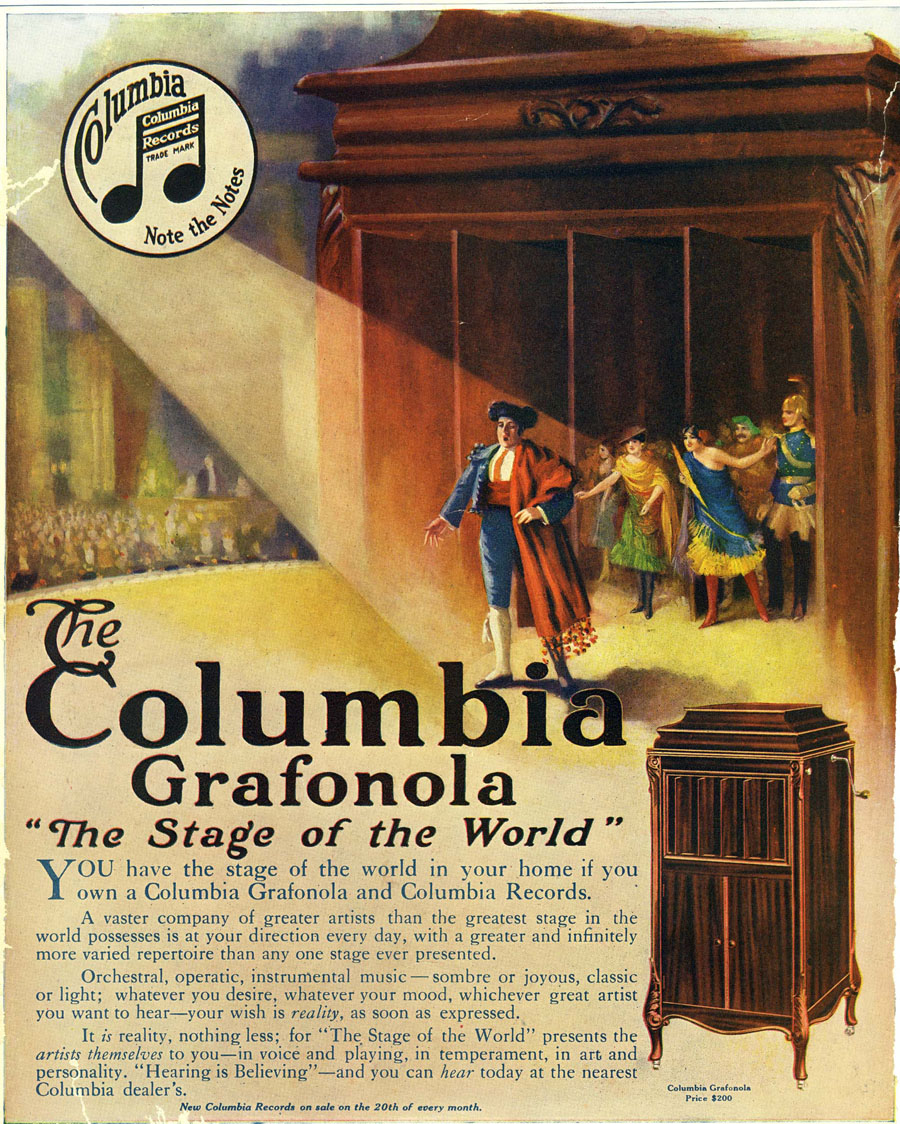
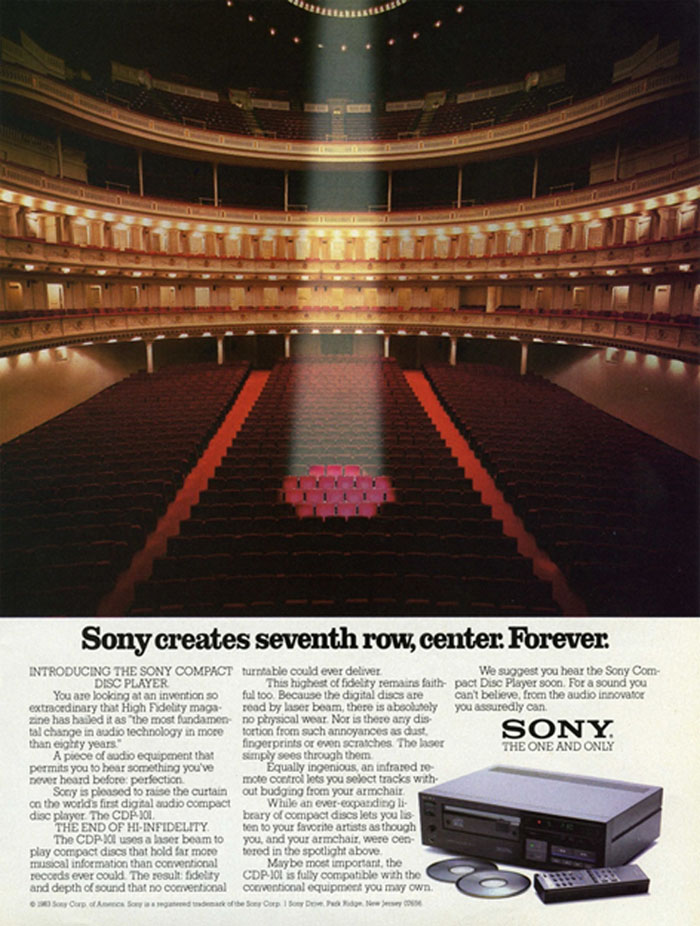
And
what about collecting?
Lorenz
Tomerius wrote that some objects become different or more interesting
based on use and ownership:
"This
refutes Gertrude Stein's claim 'a rose is a rose is a rose': that
it has become a different object if Napoleon wore it on his uniform.
A key is no longer a key if it belonged to the Bastille. A knitting
needle is an object with a special aura if Marie Antoinette made
it rattle, and a shaving kit will evoke horrible associations
if it was once owned by Danton." Lorenze Tomerius, 'Das
Glück, zu finden, Die Lust, zu zeigen' (2)
Finding Marie Antoinette's
knitting needle in the haystack would exemplify one aspect of
collecting. But there is also the more general practice of collecting
where the goal is to have all or subsets of the whatever, such
as stamps, coins, beanie babies, baseball cards, etc.
My collecting has never
been about owning all the models of phonographs made by Edison
or acquiring objects with a special provenance related to ownership
or use. Caruso didn't previously own the Victrola in my collection
and I don't own Andy Kaufman's record player with its Mighty Mouse
record that he used in the premier episode of NBC Saturday
Night Live, October 11, 1975. (3)
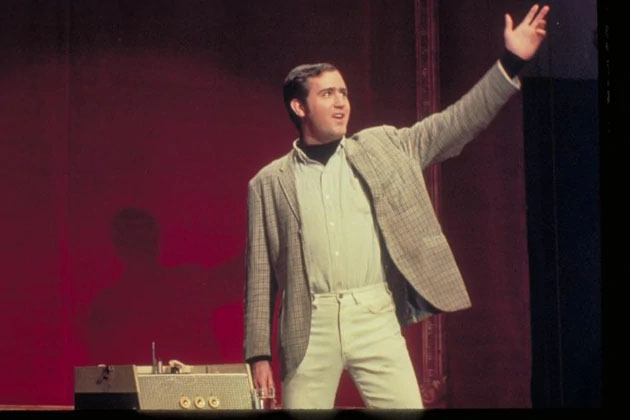
Andy Kaufman's phonograph
playing the Mighty Mouse theme song. (Courtesy NBC and
Saturday Night Live, 1975).
Instead, each object
is a "rose is a rose is a rose" in my collection of
phonographia.
But how many roses
does a collector need and what is to be done with them after they
are acquired?
Regardless of that
number the constant for me has consistently been the relationship
each 'rose' has to popular culture. Phonograph connected advertisements,
postcards, greeting cards, Valentine's cards, jokes, cartoons,
art and record album cover art each show how the phonograph's
revolution was seen in popular culture and daily life.
My collecting of objects
and ephemera has been like cutting out newspaper clippings or
saving ephemera to go into a personal scrapbook. Each selection
has its own identity and its own meaning. Ownership of phonographia
is not required to find and follow phonograph connections but
collecting has been the catalyst to see the connections and create
phonographia.com as an on-line scrapbook.
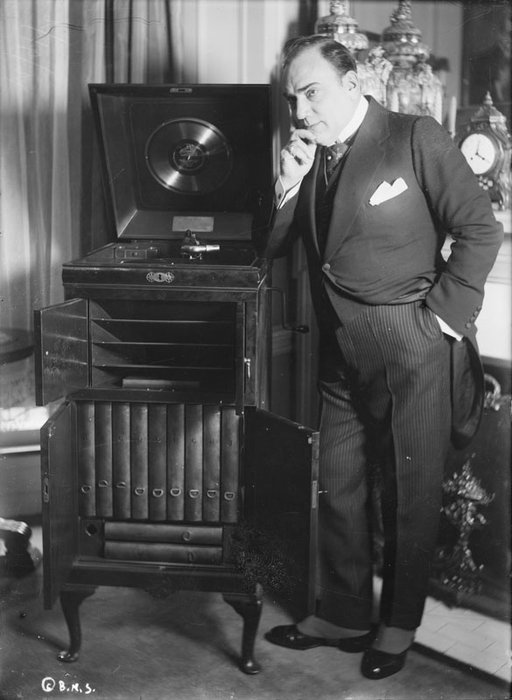
Caruso standing next
to his Victrola Queen Anne XIV
I believe phonographia
bridge time allowing us to glimpse and hear fragments of other
eras because relevant objects and stories and sounds have been
collected.
Researchers tell us
that recognition, one of the two primary forms of accessing memory
"is a simpler and more reliable process" than recall.
"It is the association of a physical object with something
previously encountered or experienced. This could be because tangible
memories utilize all five senses, evoking emotional triggers and
transporting us back to a precise time, place or moment."
(3A)
Although historical phonographs cannot be encountered by us in
their own time period, collected objects and stories and sounds
related to the phonograph can still transport us to a time that
we personally didn't experience.
In a 1995 Syracuse
University address about the Belfer Audio Archive, John Harvith
said that the Belfer Archive was important because it
"allows us to feel this sense of history even more vividly,
because we can hear what musicians, artists, authors, actors,
statesmen, politicians, and other historical figures actually
sounded like. This is emotional, visceral communication that goes
far beyond the power of the printed page. (3B)
Seeing a phonograph
in a period piece movie is another example of how time traveling
can be triggered. Watching a movie set in 1903 and seeing a gramophone
with its open horn sitting on the parlor room table is a time
period encounter and that experience can become part of your memory.
You associate a gramophone with a time and place. Hearing music
on that gramophone further enhances that memory and as Harvith
summarized in quoting musicologist James Hepokoski,
"Music of the past tells us what it felt like to live during
the period when it was created." (3C)